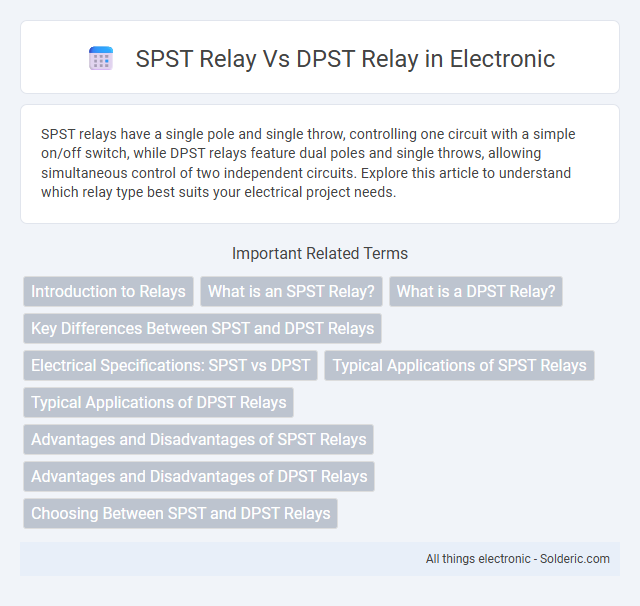SPST relays have a single pole and single throw, controlling one circuit with a simple on/off switch, while DPST relays feature dual poles and single throws, allowing simultaneous control of two independent circuits. Explore this article to understand which relay type best suits your electrical project needs.
Comparison Table
| Feature | SPST Relay | DPST Relay |
|---|---|---|
| Type | Single Pole Single Throw | Double Pole Single Throw |
| Number of Poles | 1 | 2 |
| Number of Throws | 1 (On/Off) | 1 (On/Off) |
| Switching Capability | Controls one circuit | Controls two circuits simultaneously |
| Common Uses | Simple On/Off switching, low power devices | Switching multiple isolated circuits, industrial applications |
| Size and Complexity | Compact, simpler wiring | Bulkier, more complex wiring |
| Cost | Generally lower cost | Typically higher cost due to additional poles |
Introduction to Relays
SPST (Single Pole Single Throw) and DPST (Double Pole Single Throw) relays are fundamental types of electromechanical switches used to control electrical circuits. SPST relays control one circuit by opening or closing a single set of contacts, whereas DPST relays manage two independent circuits simultaneously with two sets of contacts operating in unison. These relays are essential components in automation, providing electrical isolation and enabling low-power control of high-power devices.
What is an SPST Relay?
An SPST relay, or Single Pole Single Throw relay, is an electromechanical switch with one input and one output, controlling a single circuit by opening or closing the connection. It operates as a simple on/off switch, making it ideal for basic control applications where you need to turn a device or circuit on or off. Your choice of an SPST relay is suitable when you require straightforward switching functions without the need for multiple contacts or complex circuit configurations.
What is a DPST Relay?
A DPST relay, or Double Pole Single Throw relay, switches two separate circuits simultaneously using a single coil, providing control over two independent loads. It is commonly used in applications requiring the isolation or switching of two circuits with one relay activation, enhancing efficiency and circuit management. Unlike an SPST relay, which controls only one circuit, a DPST relay offers dual circuit control within the same device.
Key Differences Between SPST and DPST Relays
SPST relays feature a single pole and single throw, enabling control of one circuit with one input, making them ideal for simple on/off switching applications. DPST relays incorporate two poles with single throws, allowing simultaneous control of two separate circuits with one input, enhancing circuit isolation and versatility. The key difference lies in the number of poles controlled, where SPST is single-pole single-throw and DPST is double-pole single-throw, affecting their applications in electrical systems.
Electrical Specifications: SPST vs DPST
SPST (Single Pole Single Throw) relays control one circuit with one switch, typically handling voltage ratings up to 250V AC and current ratings around 10A, suitable for simple on-off applications. DPST (Double Pole Single Throw) relays switch two separate circuits simultaneously, often maintaining similar voltage ratings (up to 250V AC) but can handle double the current load due to two poles, commonly used in applications requiring isolation of both live and neutral lines. Electrical specifications like coil voltage, contact resistance, and switching power capacity are crucial for both types, with DPST relays offering enhanced control and safety in multi-circuit switching scenarios.
Typical Applications of SPST Relays
SPST relays are commonly used in simple on/off control circuits such as home lighting systems, automation devices, and basic electronic switching tasks where single pole switching is sufficient. They are ideal for applications requiring a straightforward connection or disconnection of a single load or device. Your projects benefit from SPST relays when compactness and simplicity in switching a single circuit path are priorities.
Typical Applications of DPST Relays
DPST relays are commonly used in applications that require simultaneous switching of two independent circuits with a single control signal, such as controlling both live and neutral lines in AC power distribution. These relays are ideal for isolated dual-channel control systems, motor control circuits, and double-pole switch replacements. You will find DPST relays effective in scenarios demanding higher safety and reliability where disconnecting both poles is necessary.
Advantages and Disadvantages of SPST Relays
SPST relays offer simplicity and cost-effectiveness, making them ideal for basic on/off control circuits with fewer components and easier integration. Their primary disadvantage lies in their limited switching capability, as they can control only a single circuit, unlike DPST relays which manage two circuits simultaneously. SPST relays also tend to have lower current ratings compared to DPST relays, restricting their use in applications requiring higher power handling.
Advantages and Disadvantages of DPST Relays
DPST relays provide the advantage of simultaneously controlling two separate circuits with a single switch, enhancing efficiency and reducing wiring complexity. Their ability to handle double-pole switching makes them ideal for applications requiring isolation of both line and neutral for safety. However, DPST relays tend to be bulkier and more expensive than SPST relays, and their complexity can lead to higher maintenance requirements in certain electrical systems.
Choosing Between SPST and DPST Relays
Choosing between SPST and DPST relays depends on the number of circuits you need to control; SPST relays switch a single circuit, making them ideal for simple on/off applications. DPST relays can control two independent circuits simultaneously, offering added flexibility for more complex electrical systems. Your choice should align with the required circuit load and the specific functionality of your control system.
SPST relay vs DPST relay Infographic

 solderic.com
solderic.com